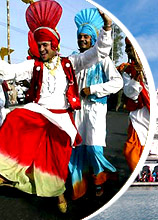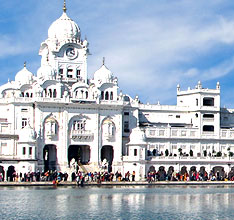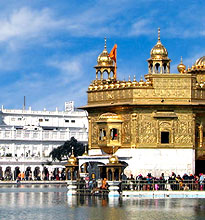 Punjabi culture is one of the oldest and richest cultures in world history, and also one of the most vibrant. The Indian state of Punjab exhibits a unique cultural landscape, which thrives in both traditional values and utilitarian aspects. There is artistry in every aspect of life in Punjab and an aura of embellishment dominates the place. The opulent culture of this northwestern state of India is apparent in its metal work, embroidery, wall paintings, jewelry, mud wall paintings, architecture, folk songs and dances. The culture of the state is wide in scope, encompassing a rich history and a pulsating social life. The century-old Punjab culture is renowned for its tolerance, progressiveness and logical approach to life as well.
Punjabi culture is one of the oldest and richest cultures in world history, and also one of the most vibrant. The Indian state of Punjab exhibits a unique cultural landscape, which thrives in both traditional values and utilitarian aspects. There is artistry in every aspect of life in Punjab and an aura of embellishment dominates the place. The opulent culture of this northwestern state of India is apparent in its metal work, embroidery, wall paintings, jewelry, mud wall paintings, architecture, folk songs and dances. The culture of the state is wide in scope, encompassing a rich history and a pulsating social life. The century-old Punjab culture is renowned for its tolerance, progressiveness and logical approach to life as well.The culture of Punjab underwent significant phases of evolution that may be broadly divided into three categories. Ancient Punjab had a rich baked-brick urban architecture. The people at that time were highly fascinated with large number of artifacts, games, such as dice, which were later excavated by archaeologists. During the Middle Age, there were number of foreign invasions in the state. Greek, Persian, Mongol and Afghan invasions had considerable influence on the cultural landscape of the state. Besides, the birth and growth of Sikhism during this period, giving a new dimension to the Punjabi culture. Today, Punjabi people are widely distributed all over the world. As a result, the traditional culture has been strengthened and expanded to the western world as well, especially US, UK and Canada.
Bhangra Dance
Bhangra is the most popular folk dance of Punjab. It represents the liveliness and dynamism of its people. The dance mainly involves men, who perform to the fast beats of drum and music. Originally performed on the Baisakhi festival, the harvest festival of Punjab, bhangra is done at every single festive occasion today.
Punjabi Dances
Punjab has a very rich tradition of dances, particularly the folk ones. The exuberance and vitality of its people are vigorously displayed in their folk dances. These dances are full of expressions, gestures, vocal remarks, subtleties of motion and unrestricted freedom.
Giddha
Giddha is a popular folk dance of Punjab, performed by the women of the region. It bears much similarity to the bhangra dance, which is performed by the men in the state. The dancers enact verses called bolis, which is a representation of folk poetry at its best. A wide range of subjects is enacted, ranging from the daily chores to the political affairs.
History of Punjab
The word 'Punjab’ appeared for the first time in the Book "Tarikh-e-Sher Shah” (1580). It describes the construction of a fort by 'Sher Khan of Punjab’. Reference to the word 'Punjab’ can be found in "Ain-e-Akbari” Part 1 as well, which describes that the territory can be divided into provinces of Lahore and Multan.
People of Punjab
Punjab is inhabited by people of diverse socio-cultural dominations. The inhabitants of the state are called the Punjabis. They are basically of Indo-Aryan ethnic origin and belong to South Asia. Numerous settlers like the Indo-Aryans, Persians, Synthians, Greeks, Arabs, Afghans and the British have invaded and ruled the region, giving it a unique culture.
Religions of Punjab
Punjab is the land where a number of religions exist in perfect harmony with each other. Sikhism and Hinduism form the major religions of the state. The other religions, like Islam, Christianity, Jainism and Buddhism, also flourish, though comparatively low in proportion.











